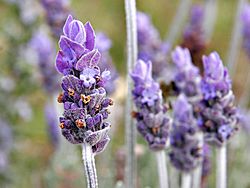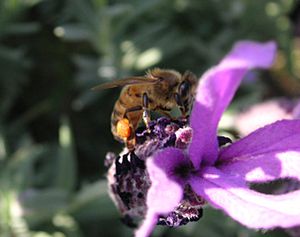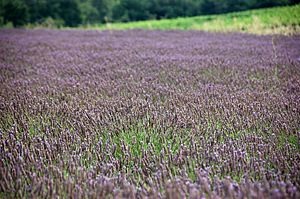Lavender facts for kids
Quick facts for kids Lavender |
|
|---|---|
 |
|
| Lavender flowers | |
| Scientific classification | |
| Kingdom: | |
| Division: | |
| Class: | |
| Order: | |
| Family: | |
| Genus: |
Lavandula
|
This article is about the plant. For the colour see Lavender (color). Lavender is a beautiful plant found on almost every continent. It is famous for its lovely purplish colour, which is so unique that a colour is even named after it! Its scientific name is Lavandula.
Lavender is used in many ways, from traditional medicine to making cosmetics and even in cooking.
Contents
What's in a Name?
The English word "lavender" first appeared around the 13th century. Most people think it comes from an old French word, lavandre. This word eventually came from the Latin word lavare, which means "to wash". This makes sense because people used to add blue lavender infusions to their bathwater!
Lavender in Gardens
Lavenders are super popular with gardeners all over the world. The most common type grown is the English lavender, also known as Lavandula angustifolia. You can find many different kinds of this plant. Other popular types for gardens include L. stoechas, L. dentata, and L. multifida (which is also called Egyptian lavender).
Because these cultivated lavenders are planted in gardens everywhere, you might sometimes see them growing wild. This happens when seeds spread beyond where they were originally planted.
How to Grow Lavender

Lavender plants grow best in dry, well-drained soil that is sandy or gravelly. They love lots of sunshine! English lavender seeds take about 14 to 28 days to sprout and are ready to harvest in about 100 to 110 days. All types of lavender need very little fertilizer and good air circulation.
If the air is too humid, lavender plants can get root rot from fungus. This is why it's a good idea to use gravel or crushed rocks around the base of the plant instead of organic mulches, which can trap too much moisture. Lavender grows best in soil with a pH between 6 and 8. Most lavender is picked by hand, and the best time to harvest depends on what it will be used for.
Lavender in Food
Lavender flowers can be used in many yummy ways! They are often used to decorate cakes because the flowers can be candied. Sometimes, they are used to add flavor to baked goods and chocolate desserts. You can even make a delicious "lavender sugar" with them. Lavender flowers are also used to make a special tea. In France, people make lavender syrup, which is then used to create tasty lavender scones and lavender marshmallows.
Lavender in Medicine
Lavender has also been used in medicine for a long time. It can even help prevent infections! For example, lavender oil was used during World War I to disinfect the walls and floors of hospitals. Lavender oil is also very helpful when applied to insect bites to soothe them.
Other Uses for Lavender
Dried lavender flowers are often placed in small pouches and put among stored clothes. This gives the clothes a fresh smell and helps keep moths away. Dried lavender flowers can also be used as wedding confetti. Beyond that, lavender is a popular ingredient in scented waters, soaps, and sachets, making many things smell wonderful.
Images for kids
-
Lavender products for sale at the San Francisco Farmers Market.
-
A lavender field in Carshalton, London Borough of Sutton.
-
A field of lavender in Hitchin, England, UK.
-
Lavandula fields near Drama, Greece.
See also
 In Spanish: Lavanda para niños
In Spanish: Lavanda para niños














